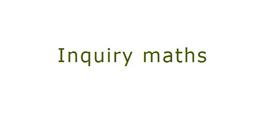Solving Linear Equations
Students are expected to be able to solve linear equations in one variable in a variety of contexts, including subject-based problems, using algebraic methods. This resource list contains a variety of activities requiring students to solve simple equations, two-step equations and equations in which the variable appears on both sides of the equation. The equations arise in a number of different contexts.
Visit the secondary mathematics webpage to access all lists.
- ALL
- Teacher guidance
- Presentation
- Activity sheet
Teacher guidance
Solving Equations Inquiry
This resource contains a simple prompt which leads to a rich task exploring the nature of linear equations.
Solving equations inquiry and the lesson notes outline the prompt for students to explore and suggests a number of supplementary enquiries. The prompt is designed to produce equations with an unknown on both sides. The discussion surrounds how the equation may be solved. Different methods could be discussed for different coefficients used in the equation.
Equations
This resource contains a variety of questions that could be used by students as consolidate work.
Equations: part A: contains questions requiring students to solve simple equations. Section 3.3 looks at writing equations to find missing angles on straight lines and section 3.4 requires students to solve equations of the form ax + b = c.
Equations: part B: Contains problems expressed in word form and a number of test questions.
Constructing and Solving Linear Equations
This resource suggests several different approaches to solving equations.
Linear equation - notes for teachers: (page 30) suggests six different ideas to help develop students' ability to solve linear equation.
Year 7 Booklet: (page 19) uses number pyramids which are easily extended to use algebraic examples. These examples have been extended so that the value of 'n' needs to be found by solving appropriate equations. The resource on page 29 gives an interesting opening to simultaneous equations.
Year 8 Booklet: (page 22) shows how the use of a number line can be used to solve equations which have an unknown on both sides.
Year 9 Booklet: (page 12) considers partitioning as a way of solving equations with the unknown on both sides.
Rearranging Equations
This resource requires students to form their own equation for a partner to solves.
Equation Sheet 1 and 2 are given to students who are required to think of an answer and form a question which will produce an equation with this solution.
Equations Card Set: extends the method requiring students to change the subject of the formula.
Presentation
Criss-crossing
In this resource students are given four coordinate points and asked to find the equation of the lines that connect them. The four lines intersect to form a rectangle- can students find the area of the rectangle?
Each student worksheet contains different coordinate points, but the solutions all have something in common.
The mathematics required to solve the problem includes; equations of lines, finding the equation of a perpendicular line, determining midpoints, and solving simultaneous equations.
There is also an interactive Geogebra file to accompany the problem.
Activity sheet
Equations
This resource contains a variety of games, puzzles and investigations. The activities appropriate to this topic are:
Pack one contains a number of activities in which students have to find the missing number in a simple calculation. These kind of activities make a good introduction to understanding the notation in simple equations. Action Equations uses a number line to help understand the process of solving simple equations and Puzzles presents a number of puzzles in words in which students are required to form and then solve an appropriate equation to solve the puzzle.
Pack two contains a range of more challenging activities. Solving Equations uses flow diagrams to solve equations whilst Letters for Lengths requires students to form equations to find the area and perimeter of rectangles.
Linear Equations
This interactive excel program from The Virtual Textbook enables students to solve different types of linear equations.
Each interactive sheet begins with an example of how the student could write out each stage of the solution. Students can click on the cells which are highlighted to reveal each step in the working. The equations on the four interactive sheets progress from ax + b=c through to a(x+b)= cx+d.
Each sheet can generate new questions and has lists of questions with positive solutions, negative or a mixture of both. Some of the interactive sheets also allow for fractional solutions.
The resource also has six sheets of questions suitable for duplication and use in the classroom
Pick a Polygon
A square-based dotted grid is given. An initial investigation involved drawing triangles on the grid and determining the area, number of dots on the perimeter, and number of dots enclosed by each triangle. The next challenge is to move on to other polygons and tabulate the results.
By inspection of the results, it is possible to deduce Pick’s theorem. A proof of Pick’s theorem is given by solving simultaneous equations.







